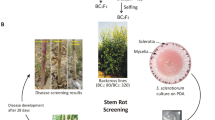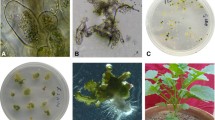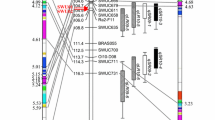Abstract
Brassica juncea is a major oilseed crop of Bangladesh, Canada, China, India, Pakistan, and the USA. The genome and pan-genome sequencing of B. juncea revealed that the gene pool maintained uniformity till now since its origin. Moreover, the selection process for higher yield and quality favors genetic homogeneity in the crop making it vulnerable to biotic and abiotic stresses. To resolve the existing problem, we have developed allohexaploid Brassica with S. alba and B. juncea by somatic hybridization. Backcross lines (BLs) from allohexaploid Brassica have been developed by backcrossing with B. juncea to transfer desirable genes for biotic and abiotic tolerance into the Brassica genome background. The first backcross population had few apparent phenotypic variations, while the second backcross generation exhibited enormous variations in agronomic characteristics and stem rot disease resistance. These BLs had plant heights, siliquae size, seeds/siliqua, seeds/plant, and 1000 seed weights of 147.6–249.6 cm, 2.88–6.5 cm, 4.4–19, 3.55–30.04 g, and 1.19–4.83 g, respectively. In terms of immunity to Sclerotinia stem rot (SSR), the BL 58 had the longest siliquae (6.5 cm) and the highest thousand seed weight (4.83 g). These BLs produced seeds that range in color from black to yellow, with varying hues of brown. The BLs were found immune to being highly susceptible to the SSR. These BLs outperform their parent in terms of agronomic traits like yellow/brown seed color, stem rot resistance, seeds/siliqua, and seed weight per plant, as well as excellent fertility. As a result, these BLs can be utilized to identify QTLs, marker assisted breeding, resistance breeding, and introgression of valuable traits to cultivated Brassica species.






Similar content being viewed by others
References
Addinsoft (2022). XLSTAT statistical and data analysis solution. New York, USA. https://www.xlstat.com/en.
Angadi SV, Cutforth HW, Miller PR, McConkey BG, Entz MH, Brandt SA, Volkmar KM (2000) Response of three Brassica species to high temperature stress during reproductive growth. Can J Plant Sci 80:693–701
Bodnaryk RP, Lamb RJ (1991) Mechanisms of resistance to the flea beetle, Phyllotreta cruciferae (Goeze), in yellow mustard seedlings, Sinapis alba L. Can J Plant Sci 71:13–20. https://doi.org/10.4141/cjps91-002
Brown J, Brown AP, Davis JB, Erickson D (1997) Intergeneric hybridization between Sinapis alba and Brassica napus. Euphytica 93:163–168. https://doi.org/10.1023/A:1002905816887
Brun H, Plessis J, Renard M (1988) Resistance of some crucifers to Alternaria brassicae (Berk.) Sacc. In Proceedings GCIRC 7th International Rapeseed Conference on Plant Breeding and Acclimatization Institute, Warsaw, 1222–1227
Conn KL, Tewari JP, Dahiya JS (1988) Resistance to Alternaria brassicae and phytoalexins-elicitation in rapeseed and other crucifers. Plant Sci 56:21–25. https://doi.org/10.1016/0168-9452(88)90180-x
Chai L, Zhang J, Li H, Zheng B, Jiang J, Cui C, Jiang L (2020) Investigation for a multi-silique trait in Brassica napus by alternative splicing analysis. PeerJ 8:8:e10135. https://doi.org/10.7717/peerj.10135
Chai L, Zhang J, Lu K, Li H, Wu L, Wan H, Zheng B, Cui C, Jiang J, Jiang L (2019) Identification of genomic regions associated with multi-silique trait in Brassica napus. BMC Genomics 23:20(1):304. https://doi.org/10.1186/s12864-019-5675-4
Gaikwad K, Kirti PB, Prakash S, Chopra VL (1996) Cytological and molecular investigations on somatic hybrids of Sinapis alba and Brassica juncea and their backcross progeny. Plant Breed 115:480–483. https://doi.org/10.1111/j.1439-0523.1996.tb00961.x
Ghosh S, Mazumder M, Mondal B, Mukherjee A, et al. (2019) Morphological and SSR marker-based genetic diversity analysis of Indian mustard (Brassica juncea L.) differing in Alternaria brassicicola tolerance. Euphytica 215:206. https://doi.org/10.1007/s10681-019-2523-1
Gupta M, Atri C, Agarwal N, Banga SS (2016) Development and molecular genetic characterization of a stable Brassica allohexaploid. Theor Appl Genet 129:2085–2100. https://doi.org/10.1007/s00122-016-2759-2
Hansen LN, Earle ED (1997) Somatic hybrids between Brassica oleracea and Sinapis alba L. with resistance to Alternaria brassicae (Berk.) Sacc. Theor Appl Genet 94:1078–1085. https://doi.org/10.1007/s001220050518
Kumari P, Bhat SR (2019) Allohexaploid H2 (IC0626000;INGR18031), an Indian mustard (Brassica juncea) germplasms with heat tolerance, resistant to Alternaria brassicae. Indian J Plant Genet Resource 32:439
Kumari P, Singh KP (2019) Characterization of stable somatic hybrids of Sinapis alba and Brassica juncea for Alternaria blight, Sclerotinia sclerotiurum resistance and heat tolerance. Indian Res J Ext Edu 19(2&3):99–103
Kumari P, Bisht DS, Bhat SR (2018) Stable, fertile somatic hybrids between Sinapis alba and Brassica juncea show resistance to Alternaria brassicae and heat stress. Plant Cell Tiss Organ Cult 133:77–86. https://doi.org/10.1007/s11240-017-1362-9
Kumari P, Singh KP, Rai PK (2020a) Draft genome of multiple resistance donor plant Sinapis alba: an insight into SSRs, annotations and phylogenetics. PLoS One 15:e0231002. https://doi.org/10.1371/journal.pone.0231002
Kumari P, Singh KP, Bisht D, Kumar S (2020b) Somatic hybrids of Sinapis alba and Brassica juncea: study of Backcross progenies for morphological variation, chromosome constitution and reaction to Alternaria brassicae. Euphytica 216:93. https://doi.org/10.1007/s10681-020-02629-3
Kumari P, Singh KP, Kumar S, Yadava DK (2020c) Development of a yellow-seeded stable allohexaploid Brassica through inter-generic somatic hybridization with a high degree of fertility and resistance to Sclerotinia sclerotiorum. Front Plant Sci 11:575591. https://doi.org/10.3389/fpls.2020c.575591
Kumari P, Bhat SR (2021) Allohexaploid (H1) (IC0628060; INGR19102), an Allohexaploid (Brassica juncea + Sinapis alba) Germplasm resistant to Alternaria brassiceae and Sclerotinia sclerotiorum tolerant. Indian J of Plant Genetic Resources 34(1):160–161
Kumari P, Bhat SR, Bhattacharya RC (2017–18) Annual Report. ICAR-National Research Centre on Plant Biotechnology Pusa Campus, New Delhi - 110012. pp50–51
Lelivelt CLC, Leunissen EHM, Frederiks HJ, Helsper JPFG, Krens FA (1993) Transfer of resistance to the beet cyst nematode (Heterodera schachtii Schm.) from Sinapis alba L. (white mustard) to the Brassica napus L. gene pool by means of sexual and somatic hybridization. Theor Appl Genet 85:688–696
Li AM, Wei CX, Jiang JJ, Zhang YT, Snowdon RJ, Wang Y (2009) Phenotypic variation in the progenies of somatic hybrids between Brassica napus and Sinapis alba. Euphytica 170:289–296
Li J, Zhang C, Guan C et al (2017) Analysis of intergeneric sexual hybridization between transgenic Brassica oleracea and Sinapis alba. Euphytica 213:271. https://doi.org/10.1007/s10681-017-2063-5
Mason AS, Yan G, Cowling WA, Nelson MN (2012) A new method for producing allohexaploid Brassica through unreduced gametes. Euphytica 186:277–287. https://doi.org/10.1007/s10681-011-0537-4
Nelson MN, Lydiate DJ (2006) New evidence from Sinapis alba L. for ancestral triplication in a crucifer genome. Genome 49(3):230–238
Nothnagel T, Budahn H, Straka P, Schrader O (1997) Successful backcrosses of somatic hybrids between Sinapis alba and Brassica oleracea with the Brassica oleracea parent. Plant Breed 116(1):89–97
Rana K, Atri C, Gupta M, Akhatar J, Prabhjodh SS, Kumar N, et al (2017) Mapping resistance responses to Sclerotinia infestation in introgression lines of Brassica juncea carrying genomic segments from wild Brassicaceae B. fruticulosa. Sci Rep 7:5904. https://doi.org/10.1038/s41598-017-05992-9
Sharma G, Kumar VD, Haque A, Bhat SR, Prakash S, Chopra VL (2002) Brassica coenospecies: a rich reservoir for genetic resistance to leaf spot caused by Alternaria brassicae. Euphytica 125:411–417. https://doi.org/10.1023/A:1016050631673
Singh KP, Kumari P, Rai PK (2021a) Current status of the disease-resistant gene(s)/QTLs, and strategies for improvement in Brassica juncea. Front Plant Sci 12:617405. https://doi.org/10.3389/fpls.2021.617405
Singh KP, Kumari P, Yadava DK (2021b) Introgression and QTL mapping conferring resistance for Alternaria brassicae in the backcross progeny of Sinapis alba+Brassica juncea somatic hybrids. Plant Cell Rep https://doi.org/10.1007/s00299-021-02785-3
Singh KP, Kumari P, Raipuria RK, Rai PK (2022) Development of genome-specific SSR markers for the identification of introgressed segments of Sinapis alba in the Brassica juncea background. 3Biotech 12:332. https://doi.org/10.1007/s13205-022-03402-0
Wang YP, Sonntag K, Rudloff E, Chen JM (2005a) Inter-generic somatic hybridization between Brassica napus and Sinapis alba. Integr J Plant Biol 47:84–91. https://doi.org/10.1111/j.1744-7909.2005.00009.x
Wang YP, Zhao XX, Sonntag K, Wehling P, Snowdon RJ (2005b) Behaviour of Sinapis alba chromosomes in a Brassica napus background revealed by genomic in-situ hybridization. Chromosome Res 13:819–826. https://doi.org/10.1007/s10577-005-1017-2
Warwick SI, Black LD (1991) Molecular systematics of Brassica and allied genera (subtribe Brassicinae, Brassiceae)—Chloroplast genome and cytodeme congruence. Theor Appl Genet 82(1):839–850. https://doi.org/10.1007/BF00231281
Zhan Z, Nwafor CC, Hou Z, Gong J, Zhu B, Jiang Y, Zhou Y, Wu J, Piao Z, Tong Y, Liu C, Zhang C (2017) Cytological and morphological analysis of hybrids between Brassicoraphanus, and Brassica napus for introgression of clubroot resistant trait into Brassica napus L. PLoS One 15:12(5):e0177470. https://doi.org/10.1371/journal.pone.0177470
Zhu J, Spanier A (1991) Resistance sources to Phoma lingam and Alternaria brassicae. Eucarpia Crucifarae Newsl 14:143
Acknowledgements
The authors acknowledged the guidance of Dr. SR Bhat, Professor, NRCPB, New Delhi during the development of stable and fertile allohexaploid Brassicas.
Funding
(1) Preetesh Kumari: (File No. YSS/2015/001849), Science and Engineering Research Board, Ministry of Science & Technology, New Delhi, India for funding the research work; (File No. SR/WOS-A/LS-373/2018), Department of Science and Technology, Ministry of Science and Technology, New Delhi, Govt. of India, India for fellowship; (2) Kaushal Pratap Singh, received Research Associateship [File No. 09/1247(0001)/2019-EMR-I] from HRDG-Council of Scientific and Industrial Research, New Delhi.
Author information
Authors and Affiliations
Contributions
PK developed the somatic hybrids of Sinapis alba + B. juncea (JS1 and JS2) and their backcross progeny, drafted and finalized the manuscript; KPS recorded morphological data, conducted the disease screening in S. alba, B. juncea and BC2F4 progeny, analyzed data, draft, and edited manuscript. PKR: provided laboratory and field facilities for phenotyping and screening for stem rot, edited manuscript. All authors read and approved the final manuscript for submission.
Corresponding author
Ethics declarations
Conflict of interest
The authors declare that they have no conflict of interest.
Additional information
Publisher's Note
Springer Nature remains neutral with regard to jurisdictional claims in published maps and institutional affiliations.
Supplementary Information
Below is the link to the electronic supplementary material.
Rights and permissions
Springer Nature or its licensor (e.g. a society or other partner) holds exclusive rights to this article under a publishing agreement with the author(s) or other rightsholder(s); author self-archiving of the accepted manuscript version of this article is solely governed by the terms of such publishing agreement and applicable law.
About this article
Cite this article
Singh, K.P., Kumari, P. & Rai, P.K. Phenotypic characterization and resistance response to Sclerotinia sclerotiorum of backcross lines developed from stable allohexaploids of Sinapis alba + Brassica juncea. Euphytica 219, 34 (2023). https://doi.org/10.1007/s10681-023-03160-x
Received:
Accepted:
Published:
DOI: https://doi.org/10.1007/s10681-023-03160-x




